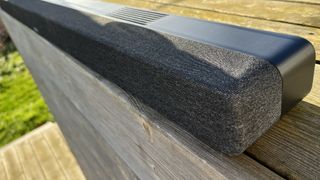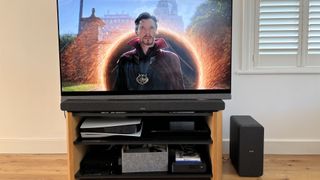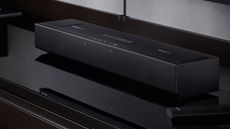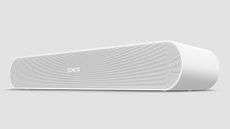Denon, it is widely acknowledged, knows exactly what’s what where multichannel home cinema audio systems are concerned. With the DHT-S517 it wants to bring the Dolby Atmos spatial audio experience to the widest possible audience using the cunning tactic of charging as little as is realistically possible.
Can it be done? Can Denon give you Atmos audio thrills without casting you into penury?
Even if you pay top whack, this isn’t a huge amount of money for a Dolby Atmos soundbar with a wireless subwoofer - and yet Denon doesn’t in any way have the field clear. A look at our pick of the best soundbars around lets you know that everyone from Bose to Sonos has a similarly sized, similarly specified dog in this particular fight. So the DHT-S517 is going to have to do a bit more than simply show up to make any kind of case for itself.
Denon DHT-S517 review: price and features
The Denon DHT-S517 is on sale now, and in the United Kingdom it’s officially priced at £379. In practice, though, it’s routinely available for less than £329 and has been spotted for pennies less than £300 on occasion. American customers are looking at $399, while in Australia it costs AU$699 or thereabouts.
For reasons best known to itself, Denon isn’t interested in revealing how much amplification power the soundbar or the subwoofer incorporate. Let’s just go with ‘adequate’ and leave it at that.

Elsewhere, though, there are details available. The soundbar, for example, features a couple of 120mm x 40mm racetrack drivers, each accompanied by a 25mm tweeter. There’s a pairing at each end of the front of the ‘bar, forming the ‘left’ and ‘right’ channels of the soundtrack. In the middle of the soundbar, a 25mm full-range driver takes care of centre-channel duties. And behind a couple of grilles on the top of the soundbar, two 66mm full-range drivers aim to provide the all-important ‘height’ element of a Dolby Atmos soundtrack.
That’s ‘3.2’ taken care of - the ‘.1’ in the DHT-S517’s ‘3.1.2’ configuration is, of course, provided by the subwoofer. It has a 15cm bass driver facing forwards, and a fairly hefty bass reflex port venting at the rear of the cabinet.
Getting audio information into the system is about as straightforward as these things ever get. As well as Bluetooth wireless connectivity, the soundbar has some physical inputs built into recesses at the ear of its cabinet - a couple of HDMI inputs (one eARC-enabled), a digital optical input, a 3.5mm analogue socket and a USB slot for servicing. There’s no Wi-Fi, though, and consequently no wider compatibility.
Denon DHT-S517 review: design and setup

Sensibly, Denon has chosen to err on the side of caution where the design of the DHT-S517 is concerned. Mind you, when you consider the specification/price ratio that’s at work here, it’s a wonder there was any money left over to employ a designer in the first place.
The soundbar part of the system is of usefully neat dimensions - at 60 x 1050 x 95mm (HxWxD) it’s not too wide to look out of place beneath a 48in TV and it’s not too high to get in the way of most of the televisions it’s likely to stand in front of. At 2.5kg, it’ll happily hang on its rudimentary key-hole fixings without jeopardising the plaster on your wall. The subwoofer, meanwhile, is an equally manageable 370 x 172 x 290mm (HxWxD) - and though it requires mains power, its wireless connectivity means it’s able to be positioned pretty much anywhere you like.
Both items are built from unremarkable but perfectly serviceable plastic, and both feature a quantity of dark grey acoustic cloth to cover their speaker drivers. Once both the sub and the soundbar have been plugged into the mains, they make a swift and stable wireless connection. And after that, control is available using a couple of different methods.
On the front of the soundbar, behind that acoustic cloth, a row of four little LEDs indicate what’s what as regards volume level, audio format and source. The five physical controls on the top of the ‘bar, which deal with ‘volume up/down’, ‘Bluetooth pairing’, ‘input selection’ and ‘power on/off’ will dictate the number of LEDs that light up at any given time, and their colour.
You may prefer to use the little remote control that’s included in the box, though. As well as duplicating the functions covered by the physical controls, the handset also includes a ‘mute’ control, an independent bass level control, and a ‘dialogue enhancer’ that basically allows you to increase or decrease the amount of midrange activity (you’ve a choice of ‘low’, ‘med’ or ‘high’). There’s also a ‘pure’ button, which defeats all the Denon’s audio processing and simply lets you have an incoming stereo signal as was intended.
Denon DHT-S517 review: performance

The DHT-S517, as sort of befits a system of two pieces, is a game of two halves where performance is concerned. Though it’s probably safe to say it gets a fair bit more right than it does wrong. Or, at least, it does once it’s been convinced of the sort of audio format it’s dealing with - very occasionally it doesn’t acknowledge the Dolby Atmos nature of an incoming signal, and has to be restarted.
The simple scale of its presentation, for example, is immediately impressive. The Dolby Atmos height effect that will be the whole point for some customers isn’t as pronounced as it might be, true… but the soundstage the Denon creates is wide, deep and has an undeniable hint of height about it. It’s very well organised, what’s more, and effects are moved around it with confidence. It’s an expansive, large-scale upgrade on the sound your TV makes, that’s for sure.
It also does very agreeable work with midrange information. Even the least talky movie features a stack of centre-channel information, and the DHT-S517 projects dialogue well. Even if the airstrike has just been called in, voices are clear, coherent and filled with detail of tone and texture - and are entirely convincing as a consequence.

As long as you keep volume levels the right side of ‘serious’, the same is broadly true of the top of the frequency range. Treble sounds have substance and bite here, carry enough variation within them to make the difference between, say, breaking glass and clattering cutlery perfectly obvious - and they’re always smoothly integrated. Get carried away with volume and the Denon will harden up quite readily at the top end, but at sensible levels it has a very nicely judged level of attack.
Things are slightly less positive at the opposite end, though. To start with, the relationship between soundbar and subwoofer could be more even - there’s no facility to adjust cross-over frequency here, after all, so the fact that the point of hand-over is so apparent is disappointing. And while the subwoofer delves deep into the frequency range, controls the attack and decay of its input well, and is more than capable of describing the biggest dynamic discrepancies, it’s far from the most detailed subwoofer around. The bass sounds it puts out are rather monotonal, so ultimately it doesn’t matter if it’s the sound of a bass drum or a collapsing building - it’s all much of a muchness to the DHT-S517’s bass box.
As far as its ability as a music system goes, the Denon doesn’t have quite the orderly, unified presentation it has when dealing with movies. A slight lack of integration between its multiple drivers is exposed by music more readily than it is by a movie soundtrack, and it means the system’s timing of music isn’t especially convincing. This isn’t an unheard-of trait in more affordable soundbar/subwoofer combos, of course, but it’s worth bearing in mind if you’re after a speaker system to do it all.
Denon DHT-S517 review: verdict

There’s lots to like - admire, even - about the DHT-S517. It’s a nicely made, low-key looker, and it delivers movie sound with real scale and confidence. Where soundstaging, effects steering and what-have-you is concerned, it’s as good as any price-comparable rival. But the soundbar isn’t on the best of terms with the subwoofer, and the subwoofer itself is something of a blunt instrument - which means the door is open to any number of rivals who want to steal the Denon’s thunder (and make off with your budget).
Denon DHT-S517 review: also consider
The Sonos Beam 2 is more expensive than the Denon DHT-S517, doesn’t have a subwoofer of any type, and relies on digital audio processing rather than actual, physical speaker drivers to create an impression of spatial audio - and yet it’s profoundly competitive. In fact, it may be the best pound-for-pound speaker in the entire Sonos line-up - which is saying something. Plus, of course, it’s a member of the most accomplished multi-room audio system available.











